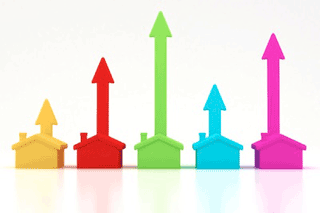Quote of the Week
“It would be the wrong thing to do – and I don’t think it would work. If borrowing is unsustainable we will be talking with APRA about prudential tools, but we are not going to use monetary policy to deal with rising house prices.”
Reserve Bank governor Philip Lowe, stating yet again that he won’t lift the official interest rate to slow down the property market.
Pandemic Blamed For Price Rises
 House prices have been “turbocharged” by the pandemic, according to KPMG, which claims prices are up to 12% higher than they would have been without the virus impact.
House prices have been “turbocharged” by the pandemic, according to KPMG, which claims prices are up to 12% higher than they would have been without the virus impact.
KPMG modelling projects that Sydney buyers will pay 26% more for a home by December 2023, double the increase if the pandemic hadn’t occurred. It predicts the average house will cost $1.24 million by 2023, compared to $1.19 million without the pandemic.
Canberra will experience a 23% rise in house values due to the pandemic, compared to just 14% in a no-pandemic scenario. Buyers in Brisbane will pay $660,000 as a result of the Covid premium, compared to $600,000 without the pandemic.
KPMG says Australian house prices are now 4% to 12% higher due to government responses to the pandemic including the HomeBuilder scheme. Initially, the uncertainty caused by the pandemic saw a fall in prices, but since then prices have been turbocharged by the pandemic.
RBA Repeats: No Rate Rise
 Reserve Bank governor Philip Lowe has assured home buyers – yet again – that he will not lift interest rates to cool housing markets.
Reserve Bank governor Philip Lowe has assured home buyers – yet again – that he will not lift interest rates to cool housing markets.
House prices have risen 15.6% nationally in the past year, says CoreLogic, with record levels of borrowing. But Lowe says there is a misconception the RBA will step in to subdue price rises by raising the official interest rate.
“It would be the wrong thing to do – and I don’t think it would work,” he says. “If borrowing is unsustainable, we will be talking to APRA about prudential tools, but we are not going to use monetary policy to deal with rising house prices.”
The RBA left the cash rate at a record low 0.1% at this month’s meeting and Lowe reiterated he does not expect a change until 2024. The bank wants inflation in the 2-3% target range before lifting the cash rate, which will require wage growth above 3% and a 4% jobless rate. Inflation is running at 1.1%, wage growth is 1.5% and the jobless rate is 5.1%.
Aust Growth Lags World’s Best
 House price growth rates in Canberra, Hobart, Darwin and Adelaide are among the top third for cities across the world, according to a new report, but lag the world’s best.
House price growth rates in Canberra, Hobart, Darwin and Adelaide are among the top third for cities across the world, according to a new report, but lag the world’s best.
The Global Residential Cities Index from Knight Frank has compared price growth in 150 cities in the March Quarter. On average, urban house prices rose 7.4% annually across the world, the highest since 2007, with 43 cities registering growth rates above 10%, led by two cities in Turkey – Izmir (34%) and Ankara (30%).
Wellington in New Zealand, Seoul in South Korea, Halifax in Canada, Moscow in Russia and Phoenix in the US also made the top 10 rankings for annual growth.
In Australia, Canberra had the highest annual growth of 15.7%, which bumped it up to 17th place in the index. Hobart’s growth rate of 13.8% placed it 23rd internationally. Darwin, with 10.8%, was in 41st place, while Adelaide was 44th, with its rate of 10%.
National Vacancy Hits 10yr Low
 The national residential rental vacancy rate fell to 1.7% in June from 1.8% in May. SQM Research says this is the lowest vacancy rate nationally since May 2011.
The national residential rental vacancy rate fell to 1.7% in June from 1.8% in May. SQM Research says this is the lowest vacancy rate nationally since May 2011.
Vacancy rates continue to fall for Sydney, Melbourne, Adelaide and Hobart. Five of the eight capital cities have vacancies below 1%, headed by Darwin and Hobart (both 0.4%).
Melbourne’s vacancy rate fell to 3.5% in June from 3.7% in May, while in Sydney vacancy rates dropped to 2.8% from 2.9%. Vacancy rates also fell further in the Sydney CBD (5.6%) and Melbourne CBD (5.8%), representing a return towards longer-term levels.
Brisbane’s vacancy rate has dropped from 2.4% a year ago to 1.3% now, while Darwin has fallen from 1.8% to 0.4% and Perth is down from 1.5% to 0.9%.
SQM Managing Director Louis Christopher says: “Rents are now accelerating in our larger capital cities which may have ramifications for the CPI read in the coming quarters.”
Canberra Leads City Rent Rises
 City rental markets continued their strong growth over the June Quarter. Domain data shows that, for the first time in 13 years, Sydney has fallen to third most expensive capital city to rent a house, despite a $10 rise to $550 per week.
City rental markets continued their strong growth over the June Quarter. Domain data shows that, for the first time in 13 years, Sydney has fallen to third most expensive capital city to rent a house, despite a $10 rise to $550 per week.
Canberra is the most expensive: house rents in the country’s capital rose $30 over the June Quarter to a record $630 a week, $60 above the same time last year – the strongest annual growth since 2007.
Darwin is the second dearest city to rent, following a 21% annual rise in house rents, the steepest incline since 2013. House rents rose $43 over the quarter to $593 a week.
Meanwhile, for the first time on record, Melbourne is the most affordable city to rent a house with prices now on par with Adelaide. However, Adelaide has hit a six-year high following four consecutive quarters of rising rents, pushing house rents to a new record of $430 a week.




